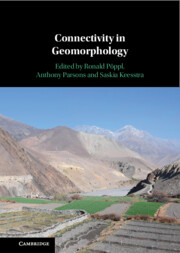Book contents
- Connectivity in Geomorphology
- Connectivity in Geomorphology
- Copyright page
- Contents
- Contributors
- Preface
- Acknowledgements
- Part I Introduction
- 1 Connectivity Concepts
- 2 Connectivity in Geomorphology
- Part II Connectivity in Process Domains
- Part III Quantifying Connectivity in Geomorphology
- Part IV Managing Connectivity
- Index
- References
1 - Connectivity Concepts
from Part I - Introduction
Published online by Cambridge University Press: 10 April 2025
- Connectivity in Geomorphology
- Connectivity in Geomorphology
- Copyright page
- Contents
- Contributors
- Preface
- Acknowledgements
- Part I Introduction
- 1 Connectivity Concepts
- 2 Connectivity in Geomorphology
- Part II Connectivity in Process Domains
- Part III Quantifying Connectivity in Geomorphology
- Part IV Managing Connectivity
- Index
- References
Summary
The concept of connectivity appeared in several disciplines in the 1950s and 1960s, but did not enter geomorphology until the 1980s. The concept has led to profound insights into the behaviour of systems, and has had significant applications in management. Connectivity may be defined as a structured set of relationships between spatially and/or temporally distinct entities), or as the degree to which a system facilitates (or impedes) the movement of matter and energy through itself. The former definition focuses on the structure of the system, and the latter on the functioning of it. The two definitions give rise to the separate concepts of structural and functional connectivity. A fundamental difference between structural and functional connectivity lies in the fact that, whereas the former can be relatively easily measured, and a variety of tools exists to do so, the latter tends to be inferred from system behaviour, so that measurement is somewhat indirect. Notwithstanding the compelling arguments in favour of studying connectivity, the ability to apply the ideas of connectivity science in any discipline requires a number of challenges to be addressed.
- Type
- Chapter
- Information
- Connectivity in Geomorphology , pp. 3 - 8Publisher: Cambridge University PressPrint publication year: 2025

